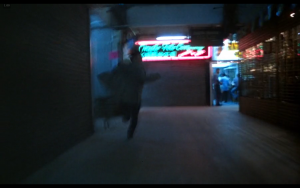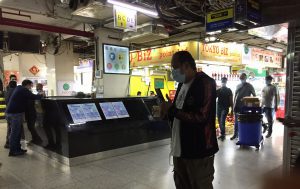CHUNGKING EXPRESS, DIR. WONG KAR-WAI (1994)
Chungking Mansions, Tsim Sha Tsui, Hong Kong
Chungking Express, released in 1994, is one of Wong Kar-wai’s most renowned films. The first half of the film follows Taiwanese cop Qiwu’s journey as he deals with a recent breakup. His story started in Chungking mansions as he swerved into the crowd on his police chase, passing by a lady in a blonde wig and sunglasses who was recruiting ethnic men into her drug smuggling team. She was threatened by her drug dealer ex-boyfriend after getting scammed by her team and tries to track them down back in the mansion. Qiwu then falls in love with her on May 1st and she leaves to kill her ex. This constant breakup and sudden romance seem pretty random, which is actually one of the film’s main themes—the possibilities of separation and connection.

Qiwu bumps into the woman in a blonde wig by sheer chance, the dark background is framed by scattered product placements on the left and passerbys on the right, which creates a feeling of crowdedness or orderlessness. Scenes from Jet Tone Production’s Chungking Express 1994, directed by Wong Kar-wai.
This theme is further illustrated in the mansion. The film depicted its environment as chaotic, mysterious or even dangerous. The opening scenes used a blue tone when introducing audiences to the building, which created a cold environment despite the presence of large crowds. Chungking in the movie was also quite orderless. Most scenes in the building featured Wong Kar-wai’s signature step-printing that creates a smudging effect and also an illusion of slow motion, confusing the eye as it can be both accelerated motion or lagging shots. Combined with the shaky and constantly panning point of view shots of the building’s happenings and inhabitants, viewers can hardly focus. However, the level of disorientation seems to be exaggerated. Upon my visit, the crowding shown wasn’t that present. There were only a few small clusters but never trafficking hallways. The visit was much more welcoming than the movie. My family did get a few glances, but people were generally kind and didn’t treat us as outsiders by speaking their language in our faces. However, the building did stay a dim maze all these years, but it was more curious than unsettling as it felt like I was travelling to a different country each corner I turn. The cultural diversity persisted with the multicultural crowds and stores, be it Pakistani, African, Indian, Chinese etc. The cultural presence wasn’t as forthright though, shops were also relatively organised with their displays. The only area That was slightly messy was some dirty corners and tangled cables in the roof.

Dark and blue tones combined with the blurriness from step-printing, the building’s interiors form a cage or void that sucks one in, the place seemed unsettling and foreign. Scenes from Jet Tone Production’s Chungking Express, 1994, directed by Wong Kar-wai.

The halls of nighttime Chungking are still dimmer than standard commercial areas and some cables/circuits are slightly messy above our heads, but nothing as cold and dangerous as the movies made it out to be. Everything was orderly, organised and not as confusing as the film suggests. It wasn’t crowded but there was still flowing of people all the time.
Crowdedness and speed all emphasize the sense of rapid connection and disconnection. The messy product displays that block the halls forced characters to share physical space, which symbolises our close yet forever-changing relationships, the mere contact and sharing of space, but also the lack of emotional connection1. The dimness and coldness may also represent the emotional disconnect, but also the mysteriousness and probabilities in the mix-match of people in urban life, where we never know who we’re going to bump into next. Much like the bustling Hong Kong, Chungking is like a “low-end globalisation”2 where cultures and people meet and part ways, further exploring the concept of chance and possibility in a flowing crowd from all around the world. Under modernisation and the pandemic, the building is no longer the same. But what persists is the possibilities and adventures that lingers within the forest of Chungking.

Filipinos mentioned near restaurant serving Indian cuisine while African music was playing all night from a nearby.
Hotels with the name of many countries exist here. Chungking Mansion is where cultures come separate but exist together, just like individuals and our relationships in modern metropolis.
References:
- Gan, Wendy. “01cm: Affectivity and urban space in Chungking Express”. University of Nottingham, Institute of Film Studies. September 06, 2010. Accessed March 12, 2021. https://www.nottingham.ac.uk/scope/documents/2003/november-2003/gan.pdf
- SCMP, Extra from “A fortunate place”. https://multimedia.scmp.com/chungking-mansions/chapter3b.html
Chan Sum Kie Dorcas, 3035792638
Appreciate that you have picked a lesser discussed storyline of Chung King Express for your field report. Chung King Mansion is indeed a melting pot of cultures and I enjoy your eloquent insights on the space and diversity it embodies around what Matthews coined as “low-end globalisation”. The ethnography done by Matthews in Ghetto at the Centre of the World would also help to support your fieldwork observations. Regarding filming techniques, you noted Wong and Doyle’s signature step-printing to depict disorientation through speed; the montage of fragmented shots might contribute to the creation of that effect as well. Overall, excellent work!